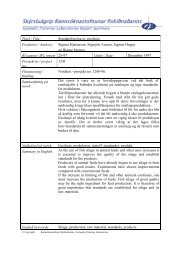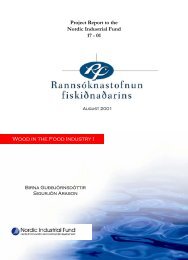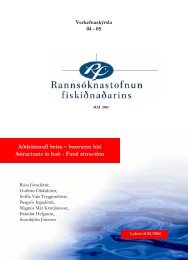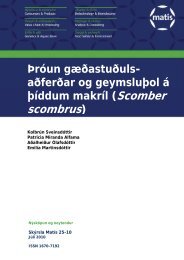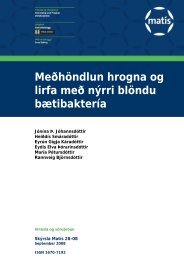Microbiology and Spoilage Trail in Nile Perch (Lates niloticus), Lake ...
Microbiology and Spoilage Trail in Nile Perch (Lates niloticus), Lake ...
Microbiology and Spoilage Trail in Nile Perch (Lates niloticus), Lake ...
You also want an ePaper? Increase the reach of your titles
YUMPU automatically turns print PDFs into web optimized ePapers that Google loves.
etween 15-20 days (2-3 weeks). Hence the estimated shelf life was likely to be 4 weeks or<br />
around 26-28 storage days as mentioned above. This is <strong>in</strong> agreement with Gram et al.,<br />
(1990) who reported long shelf life of <strong>Nile</strong> perch stored <strong>in</strong> ice of 28-30 days. The results of<br />
this study also show agreement with the study by Gram et al., (1990) for <strong>Nile</strong> perch which<br />
was spoiled after 33 days storage time. The spoilage rate of tropical water fish <strong>in</strong> ice<br />
compared to temperate water fish is considerably slower as shown <strong>in</strong> a study by Gram et<br />
al., (1987); <strong>and</strong> Ravn Jorgensen et al., (1988). Their results demonstrated that the tropical<br />
water fish generally spoiled after 4 weeks compered to 9-10 days <strong>and</strong> rarely 2-3 weeks for<br />
temprate water fish.<br />
5.2.1.2 Microbiological analysis<br />
The microbiological parameters analysed on sk<strong>in</strong> of whole <strong>Nile</strong> perch showed parallel <strong>and</strong><br />
/correlated <strong>in</strong>crease <strong>in</strong> counts throughout the storage time <strong>in</strong> ice. The TVC counts were the<br />
highest followed by SSOs counts <strong>and</strong> the lowest Enterobacteriaceae counts. The SSOs<br />
started with relatively low count but rapidly doubled (2- 6 log10 cfu/g) compared to TVC (4-<br />
6 log10 cfu/g) with<strong>in</strong> the first week of storage <strong>in</strong> ice. At the end of storage time (33 days)<br />
both SSO <strong>and</strong> TVC were > 10 log10 cfu/g while Enterobacteriaceae was > 9 log10 cfu/g.<br />
These counts of Enterobacteriaeceae are high compared to1.2 - 4.2log10cfu/cm 2 ) reported<br />
<strong>in</strong> spoil<strong>in</strong>g whole un-gutted ra<strong>in</strong>bow trout (Onchorynchus mykiss) stored <strong>in</strong> ice for over 18<br />
days storage period (Chytiri et al., 2004) . Similar low counts were reported <strong>in</strong> different<br />
fresh Mediterranean product’s shelf life (Ordonez et al. 2000; Tejada <strong>and</strong> Huidobro, 2002).<br />
In this work all analysed parameters reached between 8-9 log10 cfu/g of sk<strong>in</strong> of <strong>Nile</strong> perch<br />
after17-22 days storage <strong>in</strong> ice. Similar counts of > 10 8 cfu/cm 2 for SSOs were reported by<br />
Gram et al., (1989, 1990) after 3 weeks storage time of of whole <strong>Nile</strong> perch <strong>in</strong> ice. IMCSF,<br />
(1980b) reported TVC counts of nearly 10 8 cfu/cm 2 that rema<strong>in</strong>ed constant after 14 (>14)<br />
days of fish stored <strong>in</strong> ice. Gram et al., (1990); Gram 1990; <strong>and</strong> Huss, (1995) reported that<br />
tropical water fish <strong>in</strong> ice has longer storage life than temprate water fish because of longer<br />
lag phase between 1-2 weeks for bacterial growth <strong>in</strong> tropical water fish compared to<br />
temprate fish.<br />
In this study QIM (Organoleptic/sensory assessment) scores were far below the maximum<br />
score of 20-24 (table 5). The bacterial counts were really <strong>in</strong> high numbers beyond 8 log10<br />
60




